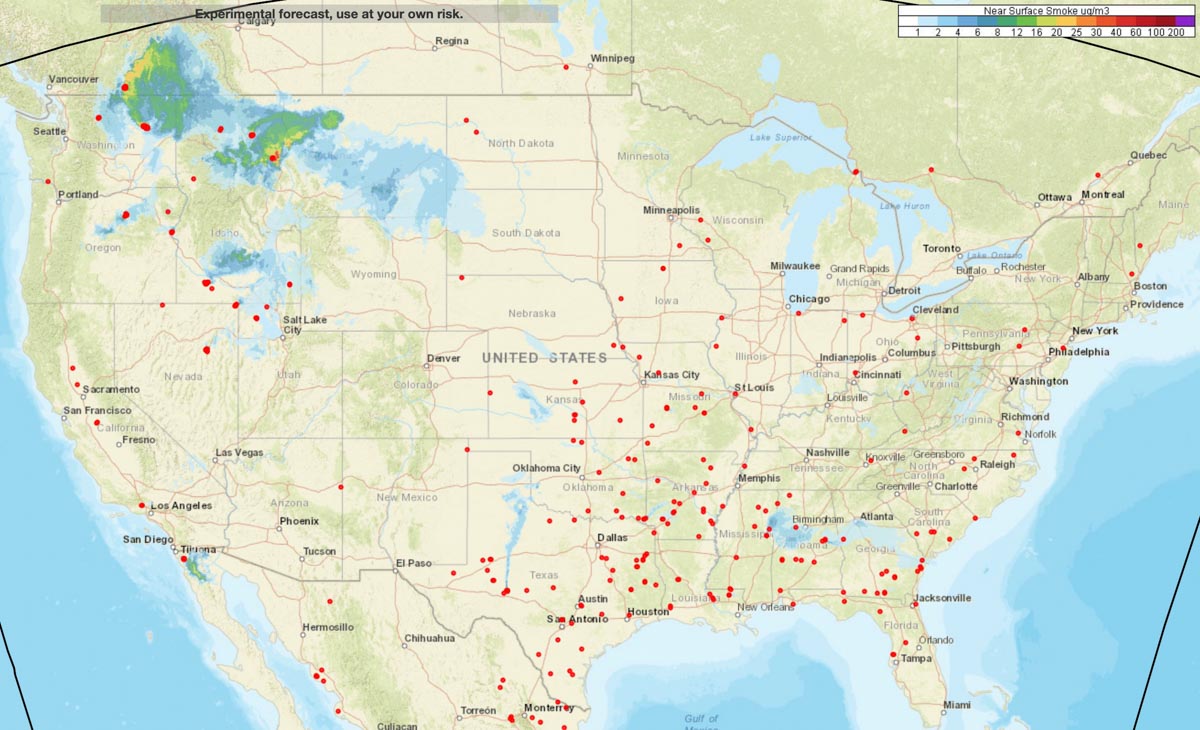These maps depict the prediction for wildfire smoke at 4 p.m. MDT August 7, 2019. As you can see, they are different. The first one is for near surface smoke — that is, smoke that is within 26 feet of the ground. The second one shows vertically integrated smoke, more than 26 feet above the ground ranging up to high in the atmosphere.
Below the maps are more details about the two different heights of smoke. Which map would you prefer to see on Wildfire Today?


“Near-surface smoke” refers to the smoke that will hover within 8 meters (26 feet) of the ground—the kind responsible for burning eyes and aggravated asthma. “Vertically integrated smoke” depicts all of the smoke in a vertical column, including smoke high in Earth’s atmosphere. That is the smoke you see at sunrise and sunset. The animation below shows a 36-hour forecast of vertically integrated smoke on August 6, 2018.
“Near-surface smoke is one indicator of air pollution, but the smoke could also be at much higher altitudes,” said Ravan Ahmadov, the main developer of the HRRR-smoke model, and a research scientist at NOAA’s Earth Systems Research Laboratory and the Cooperative Institute for Research in Environmental Sciences. “That’s important to know, because the smoke could affect visibility for aviation.” High-altitude smoke can also block incoming sunlight, which can cool air temperatures and interfere with solar energy production.”

I am an amateur astronomer who likes to go to Cherry Springs State Park with my telescope. I want to see the Vertical map, because the last time I went, forest fire smoke from Canada ruined observing, despite great clear sky weather. Next time I drive 4 hours for this, I want to make sure there is no upper atmosphere smoke in the way.
Both, either side-by-side or with a prominent toggle switch that defaults to the near-surface map. Cheers.
Well, I agree with… everyone 🙂 what I would like to see is both maps. it’s too bad there is not a way to integrate them into one map
Well, there is a way to have both on one map. They would simply be overlaid on top of each other and you would not be able to tell one from the other.
I prefer the vertically integrated smoke map. Last summer in the Denver metro we were right in the path of the smoke plumes of many of the fires in the Northwest. While the smoke was sometimes obviously near the ground (smell, sight) if I recall correctly the higher elevation smoke still affected our overall quality. It was bad enough that many people, not even those in firefighting, used the smoke maps every day as an addition to the air quality maps.
Near surface best for “can i leave my windows open overnight ?”
Near surface.
What do the red dots represent?
The red dots show the fire detections from the polar orbiting satellites.
Near Surface Map
Thank you, Bill. I concur with the above posts. Both views provide great information, but given one choice, I’d select the Near Surface Smoke.
Ground level map is far more beneficial.
I prefer the ground level map
I use this to predict where I should go for telescopic/space photography so both maps are very useful!
Both are informative ,if time and space permit . Otherwise, the near -surface map as far as health hazards.
I want to see the air I’m breathing here on the ground.